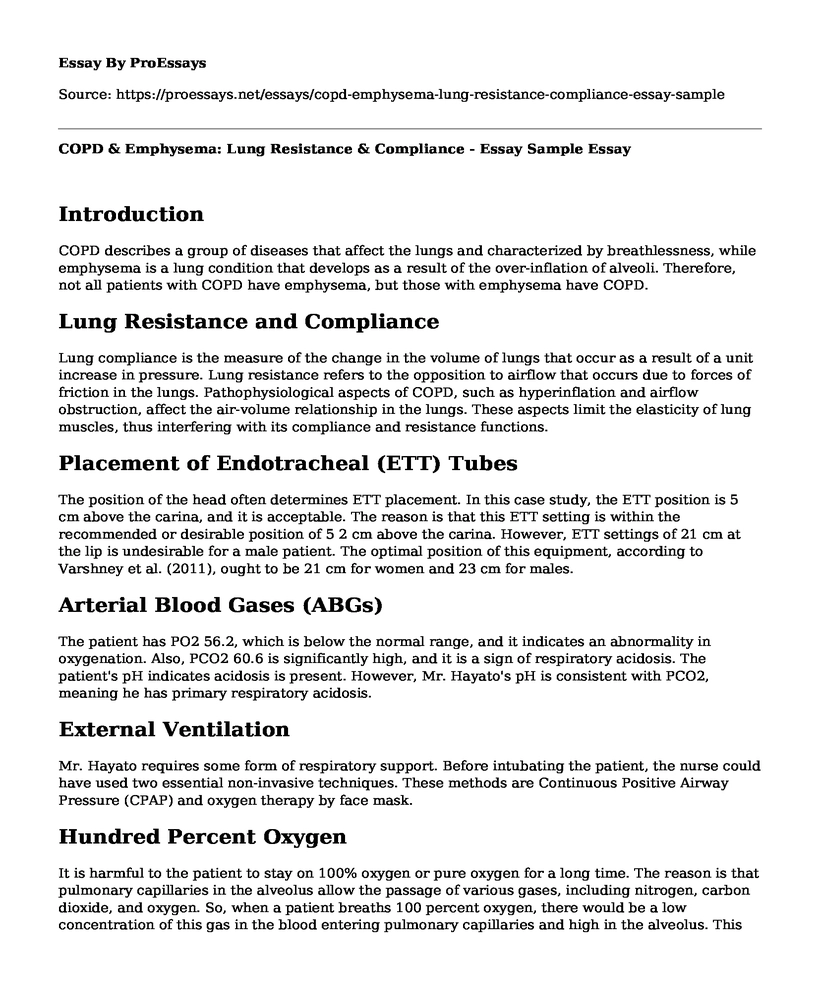Introduction
COPD describes a group of diseases that affect the lungs and characterized by breathlessness, while emphysema is a lung condition that develops as a result of the over-inflation of alveoli. Therefore, not all patients with COPD have emphysema, but those with emphysema have COPD.
Lung Resistance and Compliance
Lung compliance is the measure of the change in the volume of lungs that occur as a result of a unit increase in pressure. Lung resistance refers to the opposition to airflow that occurs due to forces of friction in the lungs. Pathophysiological aspects of COPD, such as hyperinflation and airflow obstruction, affect the air-volume relationship in the lungs. These aspects limit the elasticity of lung muscles, thus interfering with its compliance and resistance functions.
Placement of Endotracheal (ETT) Tubes
The position of the head often determines ETT placement. In this case study, the ETT position is 5 cm above the carina, and it is acceptable. The reason is that this ETT setting is within the recommended or desirable position of 5 2 cm above the carina. However, ETT settings of 21 cm at the lip is undesirable for a male patient. The optimal position of this equipment, according to Varshney et al. (2011), ought to be 21 cm for women and 23 cm for males.
Arterial Blood Gases (ABGs)
The patient has PO2 56.2, which is below the normal range, and it indicates an abnormality in oxygenation. Also, PCO2 60.6 is significantly high, and it is a sign of respiratory acidosis. The patient's pH indicates acidosis is present. However, Mr. Hayato's pH is consistent with PCO2, meaning he has primary respiratory acidosis.
External Ventilation
Mr. Hayato requires some form of respiratory support. Before intubating the patient, the nurse could have used two essential non-invasive techniques. These methods are Continuous Positive Airway Pressure (CPAP) and oxygen therapy by face mask.
Hundred Percent Oxygen
It is harmful to the patient to stay on 100% oxygen or pure oxygen for a long time. The reason is that pulmonary capillaries in the alveolus allow the passage of various gases, including nitrogen, carbon dioxide, and oxygen. So, when a patient breaths 100 percent oxygen, there would be a low concentration of this gas in the blood entering pulmonary capillaries and high in the alveolus. This imbalance in oxygen concentration would result in the accumulation of fluids in the lungs. Other effects include chest pains during deep breathing and damage of alveoli. The decline in the flow of gas across alveoli is also harmful to the patient.Importance of Peep for the Lungs
Peep refers to the extent to which alveolar pressure exceeds pressure outside the body. Precisely, it is pressure in the respiratory system or the lungs above atmospheric pressure. Peep is essential to the lungs, as it improves gas exchange. Also, it helps increase the volume of air in the lungs during expiration. Lung compliance would decline when peep is increased, and the barometric pressure in the lungs is changed since positive pressure leaves alveoli open even after expiration.
Action for the Nurse
Minor tracheal injuries occurred during intubation, which in turn caused subcutaneous emphysema. The nurse should administer medication to control pain.
Tracheal Deviation
The chest tubes have been pushed to the right side of the neck, thus causing tracheal deviation. The abnormal pressure in the patient's neck and the chest cavity caused the tracheal deviation. Some of the precautions that nurses should consider are avoiding a frequent change of chest tube positions besides stripping it. Also, they should keep the tubes below the patient's chest.
Subcutaneous Emphysema
The term refers to the gas in the subcutaneous tissues. This condition occurs when air penetrates the tissues under the skin.
Reference
Varshney, M., Kumar, R., Sharma, K., & Varshney, P. (2011). The appropriate depth of placement of oral endotracheal tube and its possible determinants in Indian adult patients. Indian Journal of Anaesthesia, 55(5), 488. https://doi.org/10.4103/0019-5049.89880
Cite this page
COPD & Emphysema: Lung Resistance & Compliance - Essay Sample. (2023, May 12). Retrieved from https://proessays.net/essays/copd-emphysema-lung-resistance-compliance-essay-sample
If you are the original author of this essay and no longer wish to have it published on the ProEssays website, please click below to request its removal:
- Implementation of Public Health Campaign: Timeline/Milestones and Marketing Strategies
- The Affordable Care Act: Impacts on Nursing Practice
- Research Paper on Factors That Determine Your Potential Lifespan in Developed Countries
- Healthcare Ethics: Safeguarding Patients' Welfare - Essay Sample
- Essay Example on Advanced Practice Nurse Decides Zoloft for Severe Depression
- Essay on My Life Dedicated to Community Service: How It Changed Me
- Essay Example on Genetically Modified Foods: Benefits for Global Food Security







